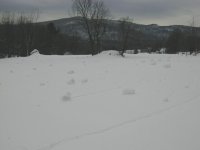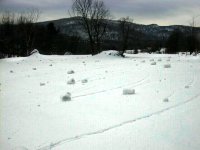Rowski
Veteran Member
- Joined
- May 18, 2000
- Messages
- 1,474
- Location
- North Central Vermont, Jay Peak Area
- Tractor
- 2004 New Holland TN70DA with 32LC loader, 2000 New Holland 2120 with Curtis cab, 7309 loader
I got some pictures of these snow rollers. They are an actual weather event. Here is a definition.
This interesting phenomenon occurs when a shallow layer of moist, but fluffy snow falls on open land at temperatures near freezing, accompanied by light wind initially. If the wind picks up substantially near the end of the snowfall, fragments of snow may be dislodged from the snow surface, then blown along that surface, with additional snow sticking to the initial fragment. The growing cylinder (because the fragment is rolling only along one axis, and not tumbling) is pushed across the open land until 1. the wind slackens, 2. its mass exceeds the ability of the wind to push it along, 3. it comes to the edge of the open area, or 4. a combination of the preceding three conditions.
Because the roller becomes more massive as it grows, the snow layers become progressively more compacted as distance from the center increases. These layers will be more durable than the less densely packed central part of the roller, so when the snow crystal structure begins to deteriorate, the core may subsequently collapse, evaporate, or be blown out by a later wind.
This event is pretty rare around here. I have never seen them untill this day. I wish I could see them happening.
Has anybody seen them happen?
This interesting phenomenon occurs when a shallow layer of moist, but fluffy snow falls on open land at temperatures near freezing, accompanied by light wind initially. If the wind picks up substantially near the end of the snowfall, fragments of snow may be dislodged from the snow surface, then blown along that surface, with additional snow sticking to the initial fragment. The growing cylinder (because the fragment is rolling only along one axis, and not tumbling) is pushed across the open land until 1. the wind slackens, 2. its mass exceeds the ability of the wind to push it along, 3. it comes to the edge of the open area, or 4. a combination of the preceding three conditions.
Because the roller becomes more massive as it grows, the snow layers become progressively more compacted as distance from the center increases. These layers will be more durable than the less densely packed central part of the roller, so when the snow crystal structure begins to deteriorate, the core may subsequently collapse, evaporate, or be blown out by a later wind.
This event is pretty rare around here. I have never seen them untill this day. I wish I could see them happening.
Has anybody seen them happen?

